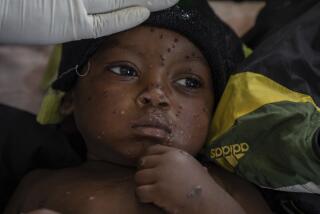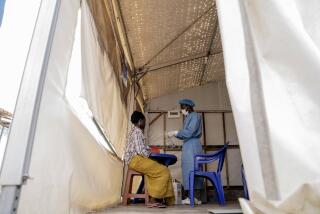New Midwest Monkeypox Cases Surface
- Share via
Nine new cases of suspected monkeypox were reported in the Midwest by state and federal health authorities Monday, bringing the total number of suspected victims to at least 37.
Only four of the cases have been confirmed by genetic tests to be monkeypox, but the disease is so distinct that it is likely most of the suspected victims actually have the virus, said Dr. Stephen M. Ostroff of the federal Centers for Disease Control and Prevention.
Meanwhile, state and federal officials are trying to track down people who may have purchased diseased pet prairie dogs, which are believed to be the source of the outbreak.
None of the victims has died and only seven have been hospitalized, but authorities are taking aggressive action to contain the epidemic for fear that the virus will obtain a permanent foothold in this country, much like the West Nile virus did after a single case was identified in New York City in 1999.
West Nile virus subsequently spread from coast to coast, infecting nearly 4,200 people last year and killing 284. Although the monkeypox virus does not seem to be as infectious -- and probably is not as lethal -- authorities would like to stop it in its tracks.
“Whenever you hear about a new virus being introduced, you have to be very concerned about the public health threat, particularly when we know it is a virus that can produce severe disease, be transmitted from human to human, and set itself up in a persistent animal reservoir,” Ostroff said.
Monkeypox is closely related to the smallpox virus but is not as infectious or deadly. Normally, it is found only in the rain forest countries of western and central Africa.
Wisconsin officials were startled a few days after Mother’s Day when 3-year-old Schyan Kautzer was hospitalized with a high fever, swollen glands and red pustules over her body -- a classic presentation of smallpox. Her parents also developed a milder form of the disease.
Scientists at the Marshfield Clinic quickly identified a virus that looked like a pox virus. The CDC heard about the finding late Wednesday and immediately dispatched a research team, which returned to Atlanta with samples Friday night. By Saturday afternoon, researchers at the CDC had confirmed that the virus was monkeypox and made the information public, looking for other cases.
As of Monday afternoon, there were 22 suspected cases in Wisconsin, 10 in Indiana and five in Illinois. Ostroff said it is “very likely” that most of the suspected cases will be confirmed.
The cases were quickly linked to contact with prairie dogs and, in one case, a rabbit. The animals were traced to a suburban Chicago business called Phil’s Pocket Pets, which specializes in small, friendly rodents. Researchers believe the prairie dogs came into contact with a Gambian giant rat, also imported as a pet, which apparently carried the virus.
State and federal health authorities are trying to track down 115 customers, both individuals and pet stores, that have purchased the prairie dogs from the store since April 15. The store’s co-owner, Phillip Moberly, told Associated Press on Monday that he had voluntarily quarantined his home-based business and killed the 70 prairie dogs he had on hand.
So far, officials have seen no evidence of human-to-human transmission of the virus in this outbreak, Ostroff said. Everyone who has caught it has been in close contact with the animals. That included six veterinarians or their assistants and “three or four” people in pet shops, he said. The rest of the victims were in families that purchased the animals. One caught it from a rabbit that had been in contact with a sick prairie dog.
Officials have warned anyone in the region with a prairie dog that appears to be ill to contact public health authorities or a veterinarian. Under no circumstances should a sick animal be released into the wild where it could infect other animals, they said.
The monkeypox virus is a member of the orthopox family of viruses, which also includes smallpox. Symptoms, which usually begin about 12 days after exposure, include fever, headache, body aches, chills, drenching sweat and sometimes a cough. One to 10 days later, these symptoms are followed by a rash with pustules that eventually crust over. Contact with the pustules is the primary source of transmission, but it can be spread by coughing.
There is no treatment for the disease, although the CDC is testing the potential utility of an antiviral drug called cidofovir. Studies in Africa suggest that 1% to 10% of victims have died, but researchers note that the higher mortality rates occurred in populations that were chronically malnourished, making it difficult to fight off the infection.
Studies in Africa have also shown that, even though the virus can be passed from person to person, it loses much of its virulence and infectivity after several generations of infection, breaking the transmission chain.
Vaccinations against smallpox apparently provide some protection against monkeypox infections.
Some researchers have noted that the ending of vaccination programs against smallpox in the 1970s -- when the disease was officially declared to be eliminated -- may have left people at greater risk for monkeypox infections.
More to Read
Sign up for Essential California
The most important California stories and recommendations in your inbox every morning.
You may occasionally receive promotional content from the Los Angeles Times.













